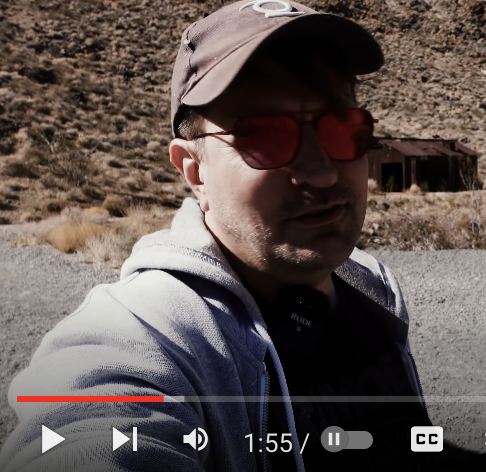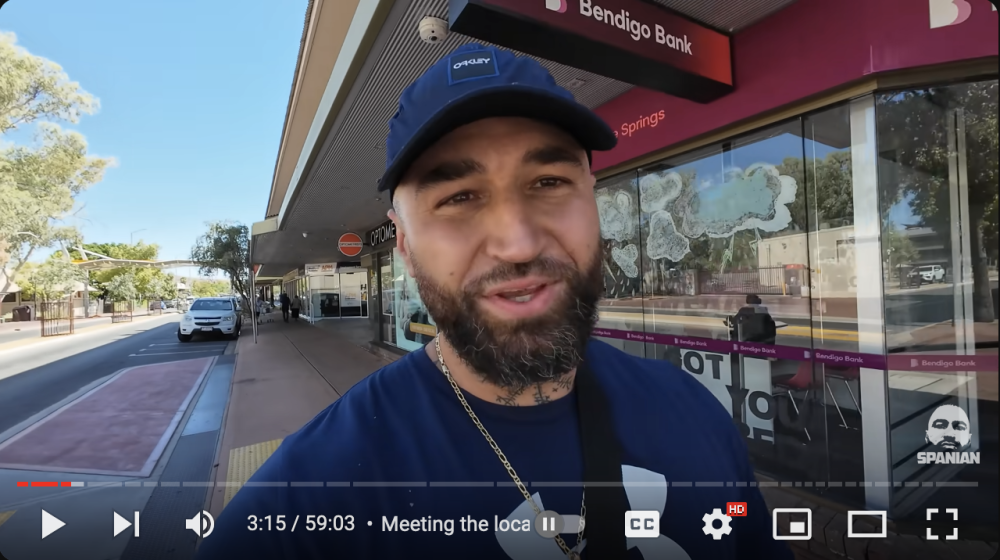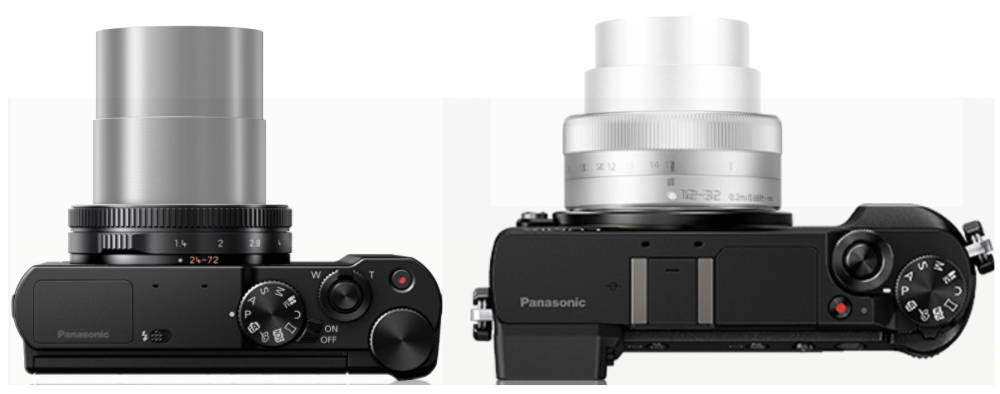-
Posts
7,985 -
Joined
-
Last visited
Content Type
Profiles
Forums
Articles
Everything posted by kye
-

Yashica Micro Mirrorless: New MILC system developed by I'm Back
kye replied to eatstoomuchjam's topic in Cameras
Cool you have a setup that works for you. I guess the thing that I noticed with the different focal lengths was that you needed the width to make it look like you weren't holding a camera. I assume this angle is the ZV-1 on the handle? Whereas this is a GoPro on a similar handle: It just doesn't have that same "I'm holding you as far away from me as I can!!" sort of vibe 🙂 I do recall parts of Asia also having signs up that said "No selfie sticks", as well as places like the Vatican IIRC? The Vatican also doesn't allow tripods either, so not sure how the handle would go if it splits into legs. Make Art Now also got a reasonable frame with the Insta360 Ace Pro by putting a diopter on it to shorten the focal distance: But, in the end, it's what's in front of the camera that matters 🙂 -

Yashica Micro Mirrorless: New MILC system developed by I'm Back
kye replied to eatstoomuchjam's topic in Cameras
When I was first getting into video I experimented with a selfie angle, but eventually realised that the videos I wanted to make didn't need it. What I learned though was: You need a super-wide angle lens, unless: - you want to be walking around with your arm extended almost the whole way, which is tiring, impractical in more crowded situations, and attracts a huge amount of attention - you want to be walking around with a camera on a stick, which has the same challenges in crowds and attracting attention - you are fine with the frame just being of your head and nothing else You don't actually need a selfie-screen You can just get used to the framing and if you put yourself in the middle of the frame then the lens distortion is fine - millions of hours of vlogging footage was recorded on Sony FF cameras with 16-35mm lenses and no flippy-screen If I was vlogging as part of my videos I'd just get one of the action cameras with a half-decent audio input and customise it from there, potentially with a diopter to adjust the focus to be perfect for the right vlogging distance and throw the background out of focus a touch. I'd also just apply un-sharpening in post to improve the image quality by 20-40%. -
Just window shopping for tiny cameras (tiny-er than the GX85) and realised I don't really care that much about the size of the camera with the lens turned off, I care about the size when I'm waving it around actually shooting footage. Comparing the LX10 with GX850+12-32mm kit lens, I think the LX10 might be longer?? The zoom ratio is only 3.0 compared to 2.66 for the 12-32, so they're almost identical lenses too. Obviously, it's smaller when closed: BUT, the LX10 lens really really extends (at least for some of its zoom range)... and (as far as I can tell) the 12-32 doesn't extend nearly as much? These are the best images I could find of the lens extended: Also, the 14-42 doesn't look much larger either: Does anyone have all these bits and can give a more definite answer? If the incognito factor is important then it might be that the GX850 and 12-32mm might be better. In fact, the LX10 might not even have much of size advantage over the GX85 with the 12-32 lens, when both are fully extended... I got a direct size comparison image and superimposed the best quality images of the two lenses extended that I could fine (the lens images are transparent so you can see the overlays - the size match is almost perfect on both). Obviously lens extension isn't everything, but in use it's potentially a factor. Members of the public are aware that the longer the lens the more zoomed it is, so anyone who is uncomfortable with the idea of being filmed from a distance might really notice such a thing.
-

Yashica Micro Mirrorless: New MILC system developed by I'm Back
kye replied to eatstoomuchjam's topic in Cameras
What a fascinating project! I wish them well, but it's not exactly what I need. I do think there is a niche here, though. The competitors are: MFT - much larger in comparison Action cameras - either don't shoot in high enough bitrates or don't have a good / large enough front-facing camera or don't have the lens options Smartphones - some don't shoot in high enough bitrates but all(?) either have one focal length on the selfie-side that isn't very wide or have several on the rear but no selfie screen at all (or it's tiny) The challenge with such a system would be the crop factor and getting lenses at the wider end - it's hard enough for the S16 crop of the P2K and M2K, but this is much worse. Perhaps the competition is a smartphone plus an action camera with front-facing screen? Still not the best combo. -
It looks to me like it was added in post as part of the grade, but obviously can't confirm that. Apparently it's the same sensor as the P4K, so until we get ISO tests I'd just assume that it's the same as that?
-
I did notice the flares - they were there but not overpowering.. I'd imagine for many who are interested in the flares in-particular that this might be an interesting option to use in situations where more typical anamorphics would flare too heavily.
-
I just realised that you have to have the handle in order to use AF... it appears there's no way to configure the buttons on the camera body itself - the manual only talks about configuring the buttons on the optional (and huge) handle.
-
Perhaps the premise of the question would be interpreted differently if the two cameras were more different to each other. For example, if I asked the same about the GH5 vs GH6, then there would be things to talk about, and spending time looking at the various specs and performance would be worthwhile. It's also helped by the likelihood that I'd own the GH5 and be questioning an upgrade - so it's a question that would have real-world implications and would be of value to discuss, rather than a purely theoretical question. In the case of the A7S3 vs A74, the strengths are very similar or don't really matter (both have enough DR for almost anything you might want to shoot) and the weaknesses are similar too.
-
I think this entire line of thinking is a product of the online camera ecosystem - it is based on the idea that cameras can be evaluated separately to them being used. It's designed to make you buy the latest stuff. It makes as much sense as having forums devoted to discussing hammers, evaluating their shapes, the materials in the handle, the hardness of the metal, etc, but without talking about using them to build something.
-
Nice images! The have a softness to the rendering that is quite filmic and very pleasing. I was wondering how much was the adapter, how much was done in post etc, then I saw that you were also using a Takumar, so that would be contributing strongly to the look too I would imagine. I'm not a huge fan of the anamorphic streaks (except in sci-fi or action films) but one thing I really like about anamorphics is the lack of artificial sharpness and the fact that the bokeh is oval-shaped it creates additional separation in a way that circular bokeh doesn't - I find it subtly contributes to the sense that cinema is in a world that is like our world but isn't quite the same.
-
Yes, a pity it doesn't have BLE. Controlling it with the BM camera app would have been really good. Will said that you can use it with a USB-C hub to connect an SSD while also powering it via USB. Have you tried that? Maybe it is just limited to connecting to one device and the USB charging doesn't count?
-
All good points, but perhaps most significantly, it has a cooling fan..... in something approaching the size of an action camera. Sony, etc, have no excuses.
-
AI invented a time machine and you've been amongst us this whole time??
-
Really? I never realised that... I think M4K just has AF-S, not AF-C. Maybe I just saw how huge the P4K was and never paid much attention beyond that!
-
You can respectfully disagree, but maybe there's a reason that no-one has done this yet....
-
There is no such thing as objectively better. There was a famous blind test that included high end cameras like the ARRI Alexa and Red Epic Dragon 6K, but also much lower-end cameras like the GH4.. here's a couple of articles talking about it: https://www.4kshooters.net/2014/08/20/12-cameras-blind-test-bmpc-4k-bmpcc-gh4-arri-alexa-red-epicdragon-6k-sony-f55-fs700-kineraw-mini-canon-c500-5d-mark-iii-1dc/ https://www.4kshooters.net/2014/08/24/12-cameras-test-part-iii-arri-alexa-red-epic-dragon-6k-blackmagic-4k-kineraw-mini-gh4-5d-mark-iii-more/ But here's the kicker - the audience was industry professionals and some of them preferred the GH4 to the ARRI or the RED. In the end, everything is subjective.
-
Actually, I take back my comments that overheating testing is incomprehensible, because I found this.... (linked to timestamp) ...and in case you don't want to hit play, the BM Micro Studio Camera was used to film inside the race car of a 24 hour race in Daytona, and: it was being powered from the car it was recording 4K to a 4TB SSD in BRAW 8:1 it recorded for 24 hours straight with no overheating and no dropped frames the average temp in the car was 120F / 48C the suspension in a race car is stiff and shaking the camera too Just goes to show - all these huge cameras that overheat in air-conditioning are just flat-out design failures.
-
Will has just released his full review of the new M4K and it looks like the sleeper camera of the decade.... One thing of extreme interest to me was that it has AF, and although he only shows it once in the video, it looks pretty snappy. Of course, he also mentions that it's the same sensor as the P4K... sooooo, the P4K sensor has AF, but the P4K does not!
-
It's partly a theoretical point, but I'm not actually sure this has to be the case. It's definitely not the case if you're comparing 709 8-bit vs LOG 8-bit, as LOG 8-bit can be so fragile that you can't even make nice images if you don't need to change WB or exposure at all. The missing piece (and why I said "I'm not sure this has to be the case") is having the colour management to convert back from 709 into something where WB and Exposure adjustments will be made proportionally to the image (ie, like they were done in-camera). I've done a lot of work with the GX85, as I'm sure you've seen, and am still planning on doing more, and I got quite good results with the Gamma wheel when the image was in 709, and using the WB and Offset controls when I'd done a CST to a LOG space (in my case using DWG/DI in Resolve). The reasons that I suggest this are that: when shooting 8-bit there is far more data in the saturation, so the impacts of quantisation are much less when grading the final image to have a normal level of saturation when shooting 8-bit the image SOOC is much closer to the final image in terms of the gamma curve, so you're not stretching those bits that much further apart than they already are, whereas 8-bit LOG needs a lot of additional contrast to be added Of course, the ultimate is having 10-bit HLG, which has full 709 levels of saturation, has a gamma curve much closer to a 709-style output but still retains all the DR from the camera, and it has all the benefits of 10-bit. Once again, HLG isn't a standard so the conversion is a challenge, but I've found that interpreting it as either Rec2020 or Rec2100 works pretty well. I'm currently programming my own grading tool in DCTL for Resolve and my main aim is to incorporate the tools that I'll need to grade 709 images, considering that the GX85 is now my main focus and it's the one that is hardest to get right with the existing tools. Once I have a working prototype I'll be filming my rec709 WB/exposure tests again (with skintones this time) and will update the other thread.
-
I think it would backfire, because the better the modified firmware got the more that people would become critical of the manufacturer for "crippling" their cameras when they were current models. You have to remember, human beings are wired to prioritise negative information over positive information - this is why newspapers are always talking doom and gloom but never reporting on the progress of eliminating polio or working towards global literacy and numeracy, etc.
-
I agree with @eatstoomuchjam that either would be fine, even for the more extreme situations. My experience has been that the GH5 (9.7 stops) often wasn't enough for people-in-front-of-sunset but that the P2K (11.2 stops) was hugely better. I wouldn't say that it's all you'd need in that situation, but it made a HUGE difference in that situation for me. Going up to the A7S3 (12.3 stops) would be a huge jump up again and would likely be all you'd need in that situation. But remember, that situation is a really demanding one, and waaaay more than you need in any other lighting scenario - the P2K (11.2 stops) is enough when the sun isn't in shot. It's fun to talk about cameras and look at the specs, but asking which is "better" involves so many variables that the situation really matters. Even things like how you feel matters because you use the camera differently.
-
No, actually, you're right.. it's me, I'm the silly one. I'd forgotten that the threads about industry news always devolve into everyone arguing about inconsequential rubbish that has no bearing on film-making. Thanks for the reminder and best of luck y'all.
-
I suggest you read the thread before posting - this is the second post from you that I've seen where you have come in half way through the conversation making comments that look a bit silly..... https://www.eoshd.com/news/adobe-cancel-nikon-n-raw-support-is-redcode-raw-coming-to-a-mirrorless-camera-near-you/ Ah, so theoretical discussion completely divorced from reality it is then. Well, umm.. good luck with that.
-
Sort-of yes, but also sort-of no. For a start, the Z9 and A1 are both top-of-the-line cameras, so if one can't beat the other given a 4X bitrate advantage, then either the sensor is absolutely rubbish, the processing is absolutely rubbish, or the codec isn't up to much. BUT, none of that matters, because unless you want to have a purely academic and theoretical discussion, you can't get a Sony sensor with N-RAW, so the variables aren't independent. BUT, none of that matters either, because soon you won't be able to get N-RAW on any camera. BUT, none of that matters either, because let's face it... any time you spend worrying about this is time you aren't spending time on what actually matters to make a good and enjoyable film.








